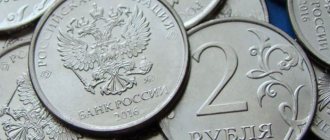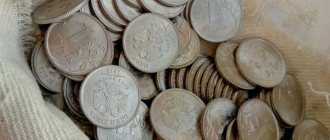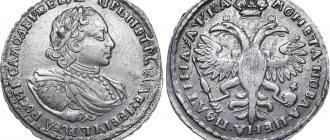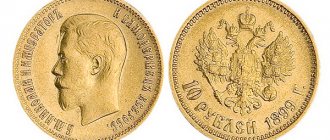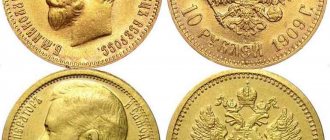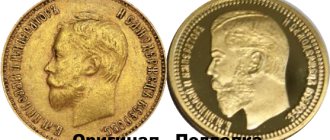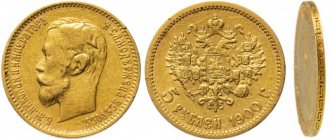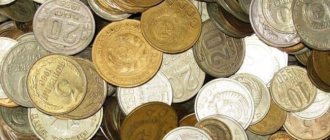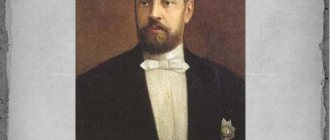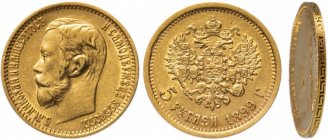There is plenty of information about the rarest and most expensive coins of modern Russia on the Internet, but not every novice numismatist will be able to understand such a huge flow of contradictory information.
In this article, in order to systematize knowledge and make it easier to work with it, valuable banknotes are divided into several groups. In the following lists and tables you can find both collectible rarities worth up to 500 thousand rubles, as well as less expensive items that are definitely available in the cash flow.
- 10 rubles
- Money without traces of circulation
How to identify a valuable coin
The value of a coin is influenced by many factors, from rare manufacturing defects to release at a certain time at a certain mint.
Rarity
First of all, rarity depends on the mintage of the coin. For example, almost all expensive coins were made at the St. Petersburg Mint. There are also rubles that for some reason do not have an identification mark; they are also considered rare.
To determine which mint a coin was minted at, special designations are used. Often these are the first two letters of the mint name.
On different denominations of coins, the designations are in different places. For example, for 5 and 3 rubles these letters are located under the right paw of the eagle, for kopecks they are under the very right hoof of the horse, and for 1 ruble they are located to the right of the wing.
If there is no such designation, then it is considered that the coin does not have a mint, which only increases the cost. Sometimes this is due to the experimental nature of the coinage. There are also coins where these “letters” are located in other places, which is an extremely rare occurrence. Because of this, the cost of such specimens reaches 100-200 thousand rubles.
Examples of designations on coins
Example of a coin without mint mark
There is a special price for coins that for some reason were not put into circulation. They may have the same denomination, but with a different obverse. Coins of this type are the rarest specimens, and receiving one in a collection is considered very prestigious.
An example of a coin that has not been put into circulation
Defects
Various defects can increase the price of a coin. One of these is the “double-sided print”. Occurs due to a manufacturing defect, during which the denomination of the coin appears on both sides.
Example of a coin with a defect
Another defect is often intentional and is in the form of "hybrid" coins. They consist of two different parts. For example, on one side there is 1 ruble, and on the other side there is an “eagle” and a denomination of 5 rubles. Such coins are very often counterfeited, so collectors are very wary of adding them to their catalogs, and these specimens are difficult to find on open sites. Such monetary units are called “mules”.
Example of a mule coin
Modern coins also have a lot of defects, intentional and not, but it makes no sense to describe each one, because... they all cost approximately the same.
State
Coin collectors value damaged pieces. This is due to the fact that it is especially difficult to damage coins. For example, splits, chips, pressing of foreign bodies, and so on are highly valued.
Example of a chip on a coin
Other criteria
The price is also influenced by factors such as:
- age of the coin - it is worth noting that in the case of Russian coins, the cost will not always be high if the coin was one of the first minted;
- precious metal content;
- rarity, anniversary edition, etc.
Often these details are minor, but still add value.
Defective coins with various types of technological defects
This refers to coins that received various defects due to violations of production technology during the minting process, but were not rejected by the mint’s control system and ended up in regular circulation. In appearance, these are the most ordinary coins, there was just some kind of glitch during their production. This does not happen often and therefore they are highly valued among collectors. The larger the defect, the more expensive it is.
Minted on non-standard blanks - color, size.
This happens when the array of blanks on which coins are minted includes circles intended for a different denomination, although they are close, but still differ in size, and sometimes in metal. For example, yellowish brass blanks for 50 kopecks (19.5 mm) are only a millimeter smaller than nickel blanks for 1 ruble. This happens sometimes, although not often.
This ruble (see below), according to the first owner of the coin, was brought from the post office. The girl, the cashier at the counter, was very depressed that one of the rubles that she had prepared for change to the client was a strange yellow color and somehow small. A young man standing next to her in line suggested that she replace this ruble with his ten. A few days later, on a numismatic forum, this copy was sold for almost 30,000 rubles, which is not a small thing and nice. The postwoman was rewarded tenfold for her attentiveness, and the young man received thousands of times more just for knowing the “price of the issue” and understanding coins. In the end, both were very pleased with themselves.
|
|
Sometimes the minting of ruble coins includes inner circles for bimetallic coins, which are significantly thicker than standard blanks; the price for such heavy rubles can reach 20 thousand rubles.
Double strike with image shift.
Double strike is a very rare minting defect. It appears as a result of a repeated impact with the press on a ready-made coin. This is possible when it is partially stuck in the stamp. When the image is re-applied, it is obtained with some shift, and the greater the shift, the higher the value of such a coin among collectors. In fact, at the mint, such defects are screened out and sent for melting. But the coins, even with slight displacements, may well slip through not very vigilant inspectors. With circulations of hundreds of millions of copies, this is quite likely. The cost of coins with a strong shift can reach 15 - 20 thousand rubles. But even if there are just minor coinage defects and even minimal image shift, collectors are willing to pay a thousand rubles or more for such specimens.
***
Split stamp.
Sooner or later, stamps become unusable; some simply break and are replaced. Coins minted with such a die are of interest to collectors until it is replaced. The metal falls into the crack that has formed and a protruding strip appears on the coin. The stronger the crack in the stamp, the thicker and longer the resulting convex line, and accordingly, the more expensive the coin. Large and full splits are especially prized - these are when a thick line goes from one edge of the coin to the other. The collection value of such rarities exceeds 1000 rubles.
Rotate the image.
If the equipment used in the minting process is incorrectly assembled or loose, the working stamps rotate. As a result, the images on one side of the coin are rotated relative to the other. Small turns (up to 45 degrees) are not of particular interest, but stronger ones, for example 90 degrees. they are already making a coin tens of times more expensive than its face value. 180-degree turns are especially in demand among collectors; if you come across one, it costs several thousand rubles.
And these are just the most common variants of coin defects; more details about the types and prices of defects on coins can be found here
. Of course, you can find such coins in everyday life, but keep in mind that everything is not so simple. The presence of rare and expensive varieties among the money traffic has led to close cooperation between numismatic dealers and cashiers, through whose hands a huge number of coins pass. Dealers are willing to pay good money to bank and store cashiers to catch such rarities for them.
2 rubles 2001, “Gagarin” - without mint monogram.
The most expensive rubles in Russia
Now the most expensive Russian rubles will be sorted out.
Ruble 2003 minted MMD
It is said that the trial minting was carried out at the SPMD, but numismatists also claim that one single copy was issued by the MMD. This coin currently costs 300 thousand rubles.
Ruble 2003 issue MMD
Ruble SPMD 2021
The price for these coins reaches 200 thousand rubles per piece. This cost is due to the fact that at the moment SPMD produces only commemorative coins, while MMD produces ordinary ones. Therefore, these specimens quickly increased in price.
Ruble 2021, made at SPMD
Ruble 2001
The value of this coin lies in the fact that, according to official data, it was never released. Nevertheless, some Russian numismatists are proud of its presence in their collections. These coins are unique and extremely rare, so their price can be significantly higher than the stated 100 thousand rubles. However, along with their uniqueness, these coins have many fakes.
Ruble 2001
How much do rare varieties cost?
Coins of the same year of issue and with the same mark of the same mint, but having slight differences, are called varieties. Some banknotes may not have varieties, while others have many. Among the varieties there are ordinary (common), infrequent and rare. The cost of the most valuable varieties can reach several tens of thousands of rubles.
Let's look at the most popular and expensive varieties of 1-ruble coins:
1 ruble 1997 MMD with wide edging
The 1997 edition with the letters MMD has two edging options. The edge (protruding edge) can be narrow or wide. The option with a wide edging is very rare. The cost of this variety reaches 6 thousand rubles.
The easiest way to distinguish the width of the edging is by looking at the reverse (the side with the floral design). Many elements of the floral ornament are hidden under the wide edging (primarily the edge of the leaf at the top, but it is also clearly visible from other elements). See the differences between narrow and wide edges in the photo:
1 ruble 1998 MMD with increased edging
The 1998 release of the MMD also has two varieties, differing in the width of the edge. A narrow edge is possible, as well as an enlarged one. But it’s difficult to call it wide; rather, we are talking about a medium-sized edging. If the edging is increased, then the price of the coin will increase to 3 thousand rubles.
The enlarged edging can be identified by the top leaf on the reverse. If there is no groove between the leaf and the edge, then the edge is enlarged (medium size).
1 ruble 2007 MMD with sheet without slots
The 2007 ruble with the symbol of the Moscow Mint (MMD) has two types of reverse. They differ in the notches on the upper leaf. A rare variety includes an image with a leaf without notches; another feature of this option is the symmetrical arrangement of the petals. This option is estimated at 300-500 rubles.
There are other rare and valuable varieties, but searching for them will require special skills and equipment to enlarge images and measure them. For those who are not deterred by this, we advise you to familiarize yourself with Alexander Stashkin’s catalog of varieties of coins from the Bank of Russia, which today is one of the most authoritative in the numismatic community.
The most expensive penny in Russia
The most expensive is the 2011 penny minted at SPMD. Its price reaches 300 thousand rubles. This is due to several factors. The first of them is that one-kopeck coins have not been minted for a long time, and this single copy is unique.
The second reason is that SPMD currently deals only with commemorative coins. These two factors gave such a fabulous price.
Kopek 2011
Also quite expensive is a coin with a face value of five kopecks. Its price reaches 250 thousand rubles. It was discovered in 2013, and then the owner put it up for auction with a starting price of 400 thousand rubles. However, differences between the photo and the real coin were immediately discovered, which immediately alerted potential buyers.
Instead of a risky start, a close study of the coin began. In the end, it was bought for 250 thousand rubles. Now a copy is being sold for a fabulous 800 thousand rubles, but no one intends to buy it yet.
Five kopecks 1999
Another expensive coin is 50 kopecks from 2001. It is not possible to determine the exact price, since at the moment the coin is not at auction, and the documents on the sale of the coin indicate “R”, that is, the price was set exclusively between the seller and the buyer.
However, we can say with confidence that the cost of this coin exceeds 100 thousand rubles. The price rose due to the fact that no one officially released it and how these 50 kopecks got to numismatists is unknown.
50 kopecks 2001
Valuable types of defects and mint errors
A large number of numismatists collect defective coins, so finding a buyer for rare types of defects is not difficult. And the cost will depend on the uniqueness of the defect; combinations of defects, as well as their extreme manifestations, are most highly valued.
A few examples:
1
. Defective stamp blockage. Sold for 360 rubles.
2
. Marriage “complete split”, issue 2011. Priced at 400 rubles.
3
. Defect “workpiece displacement” (release date - 2008). The selling price was 401 rubles.
4
. Marriage is a 180 degree turn. Such a defect went away for 800 rubles.
Interested in possible coin defects? All information about them is collected on this page: “Full overview of types of marriage: description, photos and prices.”
Mint errors and experiments
Looking at the results of auctions held in recent years, you can find an increase in the number of lots with various errors, as well as mixed-up coins.
For example, these are rubles with two obverses or two reverses, or copies minted on different blanks. Non-magnetic mugs (which were used until 2009) can be used as blanks for rubles from recent years of issue. They can be minted on circles of 50-kopeck coins, or bimetallic blanks of unknown origin can be used. There has been plenty of variety in recent years.
Can these described coins be attributed to a marriage? Numismatists have not reached a consensus. Most of these examples cannot be explained by any error in production; they could only appear as a result of someone’s commercial intent. Therefore, their cost is reduced. Previously, such unique money was estimated at 20-30 thousand, but now buyers often refuse to place bids on such lots for more than 10 thousand rubles.
Catalog of the most expensive coins in Russia
Below is a catalog that clearly shows rare coins and their value.
| Year | Denomination | Minted yard | Price (in rubles) |
| 1999 | Five kopecks | JV | 250 thousand |
| 1999 | Five rubles | SPMD | 500 thousand |
| 2001 | One ruble | M | 500 thousand |
| 2001 | Two rubles | MMD | 400 thousand |
| 2001 | Five rubles | MMD | 300 thousand |
| 2003 | One ruble | MMD | 300 thousand |
| 2003 | Two rubles | MMD | 300 thousand |
| 2003 | Five rubles | MMD | 300 thousand |
| 2006 | Five rubles | SPMD | 150 thousand |
| 2011 | One kopeck | JV | 150 thousand |
| 2011 | Five kopecks | JV | 150 thousand |
| 2011 | Ten kopecks | JV | 150 thousand |
| 2011 | Fifty kopecks | JV | 300 thousand |
| 2011 | One ruble | SPMD | 300 thousand |
| 2011 | Two rubles | SPMD | 300 thousand |
| 2011 | Five rubles | SPMD | 200 thousand |
| 2011 | Ten rubles | SPMD | 150 thousand |
| 2012 | Ten kopecks | JV | 150 thousand |
| 2012 | Fifty kopecks | JV | 300 thousand |
| 2012 | One ruble | SPMD | 300 thousand |
| 2012 | Two rubles | SPMD | 300 thousand |
| 2012 | Five rubles | SPMD | 200 thousand |
| 2012 | Ten rubles | SPMD | 150 thousand |
| 2016 | One ruble | SPMD | 300 thousand |
| 2016 | Two rubles | SPMD | 300 thousand |
| 2016 | Five rubles | SPMD | 200 thousand |
| 2016 | Ten rubles | SPMD | 150 thousand |
Remakes
Despite the fact that these coins were minted later than the date stamped on them, they are of considerable interest to a certain category of collectors. Apart from this fact, they do not differ from the usual circulation, but their quantity is very limited, and each mint has its own interesting history. How much a new-made 1 kopeck costs depends on a number of factors. As an example, we can cite the three most expensive items: 1951, 1938 and post-war 1946. Their numismatic value is respectively 40, 55 and 90 thousand rubles.
The most expensive commemorative coins of Russia
Oddly enough, commemorative coins are not considered the most expensive in Russia, and their circulations seem huge in comparison with some of the examples described above. However, among them there are rarer specimens.
1. 10-ruble coin “Yamalo-Nenets Autonomous Okrug”
The coin appeared in 2010, it was then that a lot of anniversary coins were issued with various regions, districts, republics, and so on. It was released in a limited edition, which is why the cost per copy is 16 thousand rubles.
Ten rubles “Yamalo-Nenets Autonomous Okrug”
2. 10-ruble coin “Chechen Republic”
Just like the previous coin, it came into circulation in 2010 in a limited edition. The cost per copy currently reaches 8,500 rubles.
Ten rubles “Chechen Republic”
3. 10-ruble coin “Perm Region”
The coin was released in 2010, also in an extremely limited edition. The cost per copy reaches only 3,750 rubles.
Ten rubles “Perm region”
4. 10-ruble coin “Republic of North Ossetia-Alania”
It was minted and released in 2013. Its approximate cost on the market is about 3,500 rubles.
Ten rubles “Republic of North Ossetia-Alania”
5. 10-ruble coin “Politruk”
The coin was issued in honor of the 55th anniversary of the victory in the Great Patriotic War, but its cost is ridiculous - 310 rubles apiece.
Ten-ruble coin “Politruk”
6. 10-ruble coin “Gagarin”
Minted and released to commemorate the 40th anniversary of the first man's flight into space. The cost of the coin currently reaches 300 rubles.
Ten-ruble coin "Gagarin"
7. 10-ruble coin “Population Census”
It was minted in 2010 during a large-scale population census in the Russian Federation. Has a limited edition. The cost reaches 250 rubles.
Ten-ruble coin “Population Census”
8. 10-ruble coin of the Ministry of Internal Affairs of the Russian Federation
It was minted in 2002 in honor of the Ministry of Internal Affairs of the Russian Federation in a limited edition. The cost reaches 240 rubles per piece.
Ten-ruble coin of the Ministry of Internal Affairs of the Russian Federation
9. 10-ruble coin of the Ministry of Foreign Affairs of the Russian Federation
It was also minted in 2002 in honor of the Ministry of Foreign Affairs of the Russian Federation in a limited edition. The current cost is 235 rubles per copy.
Ten-ruble coin of the Ministry of Foreign Affairs of the Russian Federation
10. 10-ruble coin “Voronezh Region”
It was produced in 2011 in honor of the Voronezh region. The circulation was limited. The cost reaches 200 rubles per copy.
Ten-ruble coin “Voronezh Region”
Counterfeit or homemade coins
Seeing such high price tags for rare banknotes, scammers do not sit idle and try to imitate the most expensive coins in Russia and sell them at a higher price to an uninformed person.
Most often, counterfeiters pass off their products as trial coining. Allegedly, the blanks were made, but they were not put into circulation.
The most striking example of such activity is 10 and 50 kopecks in 2014-2015. Their release was timed to coincide with the annexation of Crimea and the enrichment of the peninsula's economy with small change. But scammers are selling bimetallic 10 and 50 kopecks, which never existed.
Another type of deception is the minting of coins of different denominations on one blank. Now there are no coins of the same size, so it is impossible to produce this by accident. Nevertheless, scammers are actively promoting such rarities, which should cost a lot of money, of course.
The most expensive coins of Tsarist Russia
Of course, in our country there are much older coins that cost many times more than those listed above. But we are talking about pre-revolutionary Russia.
One kopeck 1726
At the moment there are very few coins left. Only 10 surviving copies are known. They were withdrawn from circulation during the reign of Catherine I. An interesting fact is that it is one of the last coins to be issued in a square shape. This was caused by the difficult economic situation in the country and the cheapness of Ural copper. Due to its unusual shape, its cost reaches 2 million rubles.
One kopeck 1726
One ruble 1705
It is the result of the monetary reform of Peter I. Thus, there were not enough resources for the production of silver coins, so Polish coins were purchased, which were used in minting.
The ruble has become a similar coin. Its value is a manufacturing defect, because the date of manufacture was incorrectly indicated. It is thanks to the error that the price of this specimen is very high in our time - 2.7 million rubles.
One ruble 1705
Two kopecks 1740
They are proof coins. During the reign of Anna Ioanovna, copper money issued under Peter I and Catherine I was in use. Their nominal value was higher than the price of the metal itself. Because of this, fakes began to appear en masse.
It is for this reason that it was decided to withdraw them from circulation and melt them into other coins - “kopeck piece”. Thus, the Empress was presented with several test copies on which her image was displayed, but the release never took place due to the death of Anna Ioanovna.
At the moment, only 6 copies have been found. The cost of the coin reaches 3.6 million rubles.
Two kopecks 1740
Twelve rubles 1836
One of the rare cases when coins for everyday circulation were made of platinum. There were three coins made from this material: 3, 6 and 12 rubles. While the first two were produced in a fairly large edition, only eleven pieces were produced of the latter. The price of this coin is 4.65 million rubles.
Twelve rubles 1836
Five rubles 1907
The coin was minted from 900-carat gold and weighed exactly four grams. Its circulation is only 109 pieces. It was not created for circulation: exactly 100 coins were to be laid in the foundation of the church that was being built near St. Petersburg.
The entire royal family was present at the laying ceremony. But nine more coins were minted. It was these copies that were distributed to the guests as souvenirs. These coins appear at various auctions. At the moment, the cost reaches 4.79 million rubles.
5 rubles 1907
Thirty-seven and a half rubles 1902
Only 235 pieces were produced, made of 900-carat gold. They have a second name “100 francs”. This coin was issued in honor of the Franco-Russian union.
An additional copy for the Hermitage was issued in 1904. Because of the value of the coin, counterfeits and remakes began to appear, which were simply covered with gold on top. The price increases from year to year. At the moment, its cost is 7.4 million rubles.
100 francs 1902
Twenty-five rubles 1908
They were released in honor of the fortieth anniversary of Nicholas II. The coins were minted from a monolithic 5-kilogram gold nugget. It was enough for 150 copies, after which 25 more pieces were minted in 1910. Nicholas used coins as a sign of attention and gave them to his subjects who distinguished themselves in the service of the Fatherland.
An interesting fact is that these rubles were a copy of exactly the same coin that was issued during the coronation of the new Emperor Nicholas II. The “gift” coins have never been in circulation and are therefore remarkably preserved. Every year at auctions they increase in price, at the moment the cost is 9.3 million rubles.
Twenty-five rubles 1908
One ruble 1825
Opens the top three most valuable coins of pre-revolutionary Russia. A total of six specimens are known. This coin is interesting because it depicts an emperor who did not ascend to the throne.
It happened like this: when the monarch changed, the mint began to issue coins with the new emperor in advance. It was assumed that after the death of Alexander I, his brother Konstantin Pavlovich would be crowned. No one knew that the heir had abdicated the throne. As a result, Nicholas I was proclaimed tsar.
To hide the oversight, the coins were kept secret. Among these copies, fakes often appear. The cost of the real coin is 22 million rubles.
One ruble 1825
One ruble 1730
The exact circulation of the coin has not yet been established. This is due to the fact that it was originally a trial sample. At the moment, three such rubles are known.
Numismatists nicknamed this coin “Anna with a chain.” This name comes from the fact that the obverse is decorated with the face of Anna Ioannovna, and the reverse side with a double-headed eagle, which is surrounded by the chain of St. Andrew the First-Called. In modern times, the coin is valued at 25.6 million rubles.
One ruble 1730
Twenty rubles 1755
This coin has been the most expensive coin from the reign of the Romanov dynasty for several decades. It was an exclusively proof piece, weighing 33 grams, made of 917 gold. Empress Elizabeth was depicted on one side.
It is the first Russian coin on which the inscription “gold” was minted. Collectors nicknamed it “Elizabethan Gold”. Only two copies are known, since further coinage was not approved. The current cost is 77 million rubles.
Twenty rubles 1755
Coins 1992 - 1993
The first coins after the collapse of the USSR were issued by the Moscow and Leningrad mints. The denomination of the new coins began with 1 ruble and ended with 100 rubles. The hammer and sickle on the reverse was replaced by a double-headed eagle. Copper-nickel alloy, brass-plated steel and bronze were used for minting.
In 1992, 3 commemorative bimetal coins of 10 rubles each, belonging to the Red Book series, were also issued. However, today they have little value.
In 1993, new alloys began to be used when issuing coins, for example, steel with nickel silver coating. Updated 10, 20, 50 and 100 rubles appeared in circulation.
The most valuable coins of modern Russia for 1992-1993:
- 10 rub. 1992 State Emergency Committee - up to 11 thousand rubles;
- 10 rub. 1992 MMD magnetic – up to 18 thousand rubles;
- 10 rub. 1993 MMD – up to 10 thousand rubles;
- 10 rub. 1993 LMD non-magnetic – up to 30 thousand rubles;
- 20 rub. 1993 MMD – up to 20 thousand rubles;
- 20 rub. 1993 LMD – up to 100 thousand rubles;
- 50 rub. 1993 LMD – up to 60 thousand rubles.
How to spot a fake
It should immediately be noted that without the proper skills and tools, it is extremely difficult to distinguish a counterfeit coin from a real one. The exceptions are completely crude fakes. However, there are general tips that can help you protect yourself from counterfeits.
General form
First, you should do the most basic check: measure the diameter, weight and thickness of the coin. Next, you should take a close look at the lines of the coin and the clarity of casting or minting.
It must be remembered that if the coin is made by casting, the ground may be dull. This is what in most cases is a sign of a fake. If bubbles are found on the coin, then with a 99% probability it is a fake.
The last thing to pay attention to is the imagery on the coin. If it is fake, then all the drawings on its surface may be blurry or incorrect, and the mint mark may be completely absent.
Loading …
Where to evaluate and how to sell expensive rare coins?
Rare coin found! What to do next?
Grade
To evaluate your finds and sell them in the future, you will need good photographs.
Take photos in bright daylight. Usually, in such conditions, a simple smartphone is enough for high-quality photos. Be sure to trim the edges of the photo, removing all excess; rotate the image so that the date is at the bottom.
An example of successful photographs, from such photos you can easily make an assessment and sell it profitably
You can evaluate it yourself (by finding sales of similar coins on the Internet) or by contacting numismatic forums . For example, you will always find help on the forums: coins.lave.ru and coins.su
On the forums, be sure to read the rules, post your question, attaching a photo, in the appropriate topic, and describe in detail the coin for which you require grading. If you do everything correctly, expert help will not be long in coming.
You should not evaluate coins in so-called purchases, which make money by purchasing valuable coins in large quantities. Experts in such places are interested in lower estimates.
"Mix-ups"
Some of the examples described above can also be classified as mix-ups, but by and large this is what is commonly called the use of inappropriate coin discs. When stamping on blanks not intended for a given denomination, the image may shift, occupying the entire coin field or, conversely, leaving too much free space. This should also include coins whose obverse and reverse do not correspond to each other, where they are not a standard circulation pair. Collectors are always very interested in such coins, so they can be very expensive.
The two most significant examples of 1 kopeck in this regard:
- 1924 Among the mintage of this year, specimens were found with a reverse corresponding to a 20-kopeck coin of the same year of issue. Estimated at 1.5 hundred thousand rubles.
- 1957, already mentioned above, with a mixed coat of arms, having 16 ribbons, and valued at more than half a million.
Only the most valuable and expensive penny coins of the Soviet period are listed here. In fact, the list of interesting examples of this small and insignificant denomination for a modern person is much longer. But it should be emphasized once again that, firstly, when announcing the estimated amounts, we are talking about coins of impeccable preservation, and secondly, it should be recalled that the numismatic market is one of the most dynamic and unpredictable, and the evaluation criteria for each position can be very great progress not only in the long term, but also in the short term.
